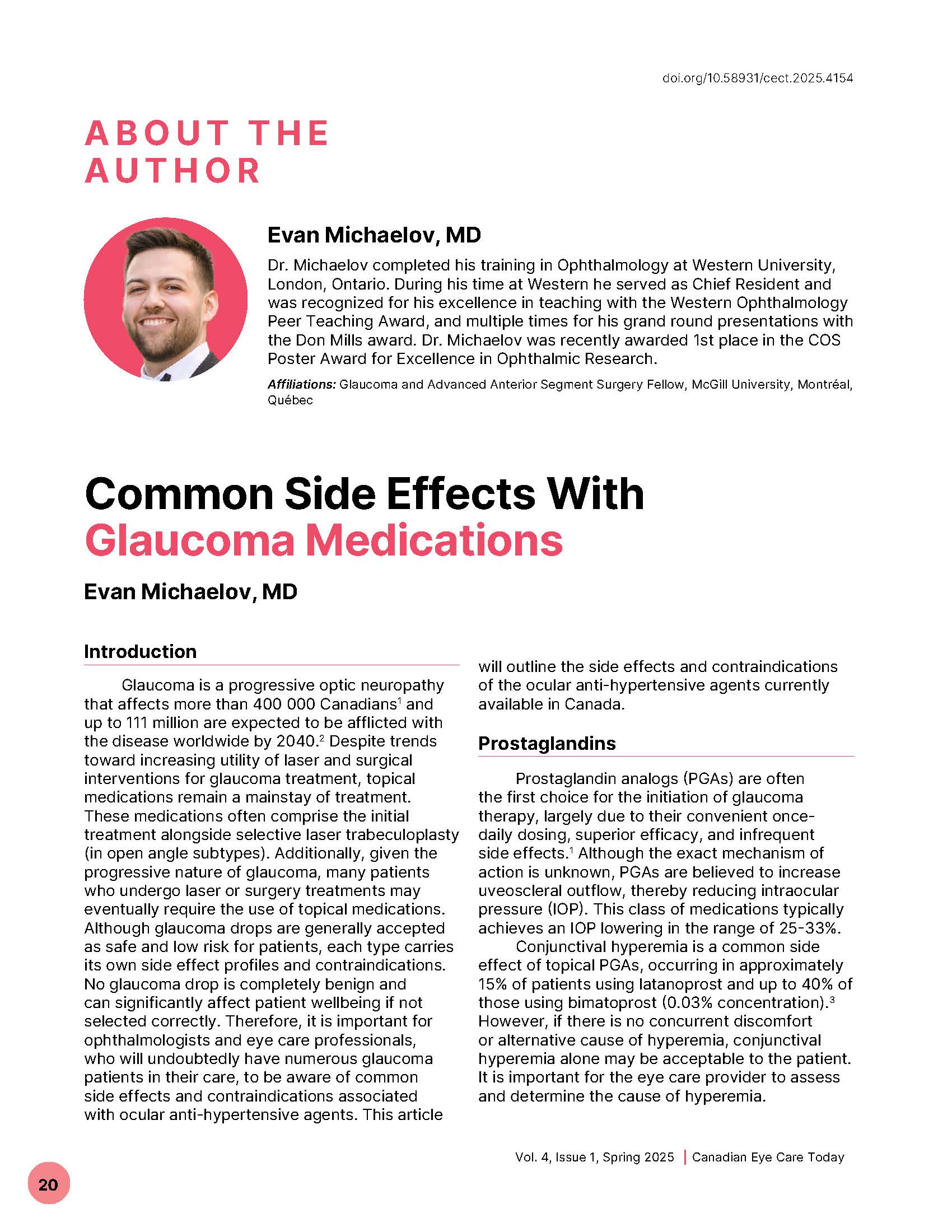Common Side Effects With Glaucoma Medications
DOI:
https://doi.org/10.58931/cect.2025.4154Abstract
Glaucoma is a progressive optic neuropathy that affects more than 400 000 Canadians and up to 111 million are expected to be afflicted with the disease worldwide by 2040. Despite trends toward increasing utility of laser and surgical interventions for glaucoma treatment, topical medications remain a mainstay of treatment. These medications often comprise the initial treatment alongside selective laser trabeculoplasty (in open angle subtypes). Additionally, given the progressive nature of glaucoma, many patients who undergo laser or surgery treatments may eventually require the use of topical medications. Although glaucoma drops are generally accepted as safe and low risk for patients, each type carries its own side effect profiles and contraindications. No glaucoma drop is completely benign and can significantly affect patient wellbeing if not selected correctly. Therefore, it is important for ophthalmologists and eye care professionals, who will undoubtedly have numerous glaucoma patients in their care, to be aware of common side effects and contraindications associated with ocular anti-hypertensive agents. This article will outline the side effects and contraindications of the ocular anti-hypertensive agents currently available in Canada.
References
Harasymowycz P, Birt C, Gooi P, Heckler L, Hutnik C, Jinapriya D, et al. Medical management of glaucoma in the 21st century from a Canadian perspective. J Ophthalmol. 2016;2016:6509809. doi:10.1155/2016/6509809 DOI: https://doi.org/10.1155/2016/6509809
Tham YC, Li X, Wong TY, Quigley HA, Aung T, Cheng CY. Global prevalence of glaucoma and projections of glaucoma burden through 2040: a systematic review and meta-analysis. Ophthalmology. 2014;121(11):2081-2090. doi:10.1016/j.ophtha.2014.05.013 DOI: https://doi.org/10.1016/j.ophtha.2014.05.013
Honrubia F, García-Sánchez J, Polo V, de la Casa JM, Soto J. Conjunctival hyperaemia with the use of latanoprost versus other prostaglandin analogues in patients with ocular hypertension or glaucoma: a meta-analysis of randomised clinical trials. Br J Ophthalmol. 2009;93(3):316-321. doi:10.1136/bjo.2007.135111 DOI: https://doi.org/10.1136/bjo.2007.135111
Teus MA, Arranz-Márquez E, Lucea-Suescun P. Incidence of iris colour change in latanoprost treated eyes. Br J Ophthalmol. 2002;86(10):1085-1088. doi:10.1136/bjo.86.10.1085 DOI: https://doi.org/10.1136/bjo.86.10.1085
Zhou Y, Bicket AK, Marwah S, Stein JD, Kishor KS. Incidence of acute cystoid macular edema after starting a prostaglandin analog compared with other classes of glaucoma medications. Ophthalmol Glaucoma. 2025;8(1):4-11. doi:10.1016/j.ogla.2024.07.010 DOI: https://doi.org/10.1016/j.ogla.2024.07.010
Meyer JH, Brandi-Dohrn J, Funk J. Twenty four hour blood pressure monitoring in normal tension glaucoma. Br J Ophthalmol. 1996;80(10):864-867. doi:10.1136/bjo.80.10.864 DOI: https://doi.org/10.1136/bjo.80.10.864
Konowal A, Morrison JC, Brown SV, Cooke DL, Maguire LJ, Verdier DV, et al. Irreversible corneal decompensation in patients treated with topical dorzolamide. Am J Ophthalmol. 1999;127(4):403-406. doi:10.1016/s0002-9394(98)00438-3 DOI: https://doi.org/10.1016/S0002-9394(98)00438-3
Lee AG, Anderson R, Kardon RH, Wall M. Presumed “sulfa allergy” in patients with intracranial hypertension treated with acetazolamide or furosemide: cross-reactivity, myth or reality? Am J Ophthalmol. 2004;138(1):114-118. doi:10.1016/j.ajo.2004.02.019 DOI: https://doi.org/10.1016/j.ajo.2004.02.019
McLaurin E, Cavet ME, Gomes PJ, Ciolino JB. Brimonidine ophthalmic solution 0.025% for reduction of ocular redness: a randomized clinical trial. Optom Vis Sci. 2018;95(3):264-271. doi:10.1097/opx.0000000000001182 DOI: https://doi.org/10.1097/OPX.0000000000001182
Blondeau P, Rousseau JA. Allergic reactions to brimonidine in patients treated for glaucoma. Can J Ophthalmol. 2002;37(1):21-26. doi:10.1016/s0008-4182(02)80094-1 DOI: https://doi.org/10.1016/S0008-4182(02)80094-1
Beltz J, Zamir E. Brimonidine induced anterior uveitis. Ocul Immunol Inflamm. 2016;24(2):128-133. doi:10.3109/09273948.2015.1037845 DOI: https://doi.org/10.3109/09273948.2015.1037845
Elhusseiny AM, Chauhan MZ, Jabbehdari S, Alshammari N, Jong S, Phillips PH, et al. Using real-world data to assess the association of retinal detachment with topical pilocarpine use. Am J Ophthalmol. 2025;271:1-6. doi:10.1016/j.ajo.2024.10.035 DOI: https://doi.org/10.1016/j.ajo.2024.10.035
Safitri A, Konstantakopoulou E, Hu K, Gazzard G. Treatment expectations in glaucoma: what matters most to patients? Eye (Lond). 2023;37(16):3446-3454. doi:10.1038/s41433-023-02532-w DOI: https://doi.org/10.1038/s41433-023-02532-w
Konstantakopoulou E, Gazzard G, Garway-Heath D, Adeleke M, Ambler G, Vickerstaff V, et al. Selective laser trabeculoplasty after medical treatment for glaucoma or ocular hypertension. JAMA Ophthalmol. 2025. doi:10.1001/jamaophthalmol.2024.6492 DOI: https://doi.org/10.1001/jamaophthalmol.2024.6492

Downloads
Published
How to Cite
Issue
Section
License
Copyright (c) 2025 Canadian Eye Care Today

This work is licensed under a Creative Commons Attribution-NonCommercial-NoDerivatives 4.0 International License.
